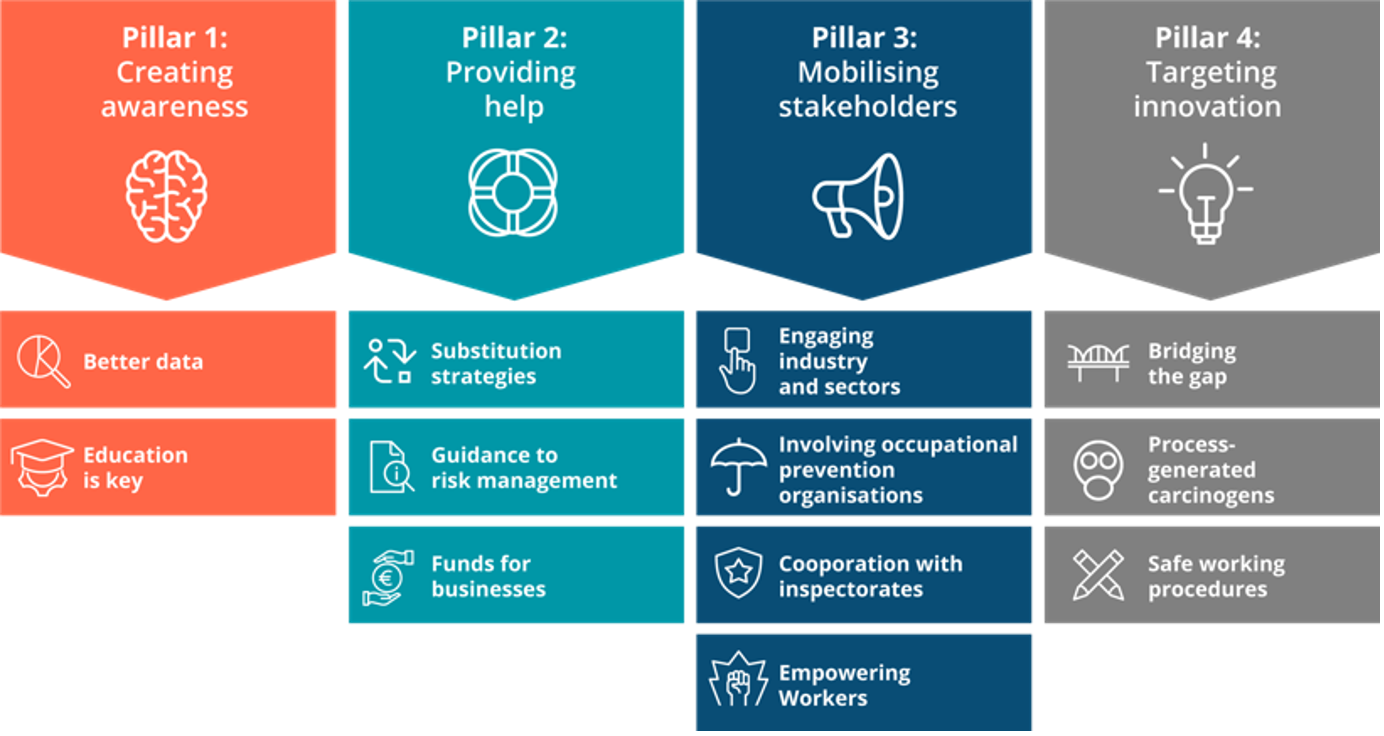
From 2021, the Roadmap on Carcinogens started running twelve challenges to gain further impact, to help prevent workers from getting exposed to carcinogens (read the full strategy here).
For the period 2020-2024 the Roadmap has established the following four goals:
- Pillar 1: Creating awareness through Europe among businesses and workers on the risks of exposure to carcinogenic substances and the need for preventive actions.
- Pillar 2: Providing help to businesses and workers in preventing exposure to carcinogens on the work floor and minimize its effect on the workforce.
- Pillar 3: Engaging industry and sectors and increasing the involvement of relevant parties to multiply our efforts throughout Europe.
- Pillar 4: Targeting innovation to bridge the gap between research findings and businesses’ needs.
These pillars have been divided into 12 challenges. Executing these challenges will all contribute in reaching these goals. Every challenge is run by a team from the Roadmap partners.
Challenge 1.1 – Better data
Better and more detailed data on exposure to carcinogens is essential to raise awareness on the need for action and to monitor – especially on the long run – if we are able to see a decline in the use of cancer causing agents on the shop floor.
Results:
- A detailed report is available (pdf).
- An overview of exposure measurement databases is available on this website
- An overview of registers on workers exposed to carcinogens is available on this website
- Joint research projects providing data on occupational carcinogen exposure (pdf)
Challenge 1.2 – Education is Key
True to the motto ‘You can’t teach an old dog new tricks’ it is necessary to start with awareness raising activities in primary schools and integrate it better in vocational educational training.
Results:
- A set of educational presentations for primary school teachers will be available soon.
- A gamification tool has been developed and is made available through this website.
Challenge 2.1 – Subsitution strategies
Substitution with safer alternatives is at the top of the hierarchy of measures to prevent exposure to cancer causing agents at work and collecting substitution and innovation examples will provide help to companies in search for their successful substitution plan.
- Comprehensive summaries for alternatives from the REACH authorisation applications are available through this website under each fact.
- Possible alternatives for chromium trioxide as a plating agent for use in general manufacturing can be found here
Challenge 2.2 – Guidance to Risk Management
The aim of this challenge was to provide guidance to risk management and create awareness for the risk reduction strategies according to the STOP principle. Beside creating leaflets on the latter, the challenge team screened many task-specific con-trol guidance sheets to collect general features for a template. This supports the creation of control guidance sheets (CGS) and helps to communicate the most im-portant aspects for risk management of carcinogens. The content of the S – T – O – P leaflets is included on the website.
More results from the challenge will be available soon:
- Downloadable S – T – O – P leaflets.
- A platform that institutions can use to generate CGS based on the template developed by the challenge team. The resulting CGS for employers will be shared on the website.
- Challenges 2.2 report
Challenge 2.3 – Funds for businesses
It is known that different organisations, like Member States, Industries or Sector organisations, national Social Security, Insurance initiatives and others, already have funds or specific fiscal measures in place that stimulate businesses to invest in occupational safety and health.
Challenge 3.1 – Engaging industries and sectors
The more cross-industry and sectoral organisations can be mobilised to join the Roadmap on Carcinogens, the more businesses will benefit from the mapped and explained solutions.
Challenge 3.2 – Involving occupational prevention organisations
Involving stakeholders such as occupational prevention organisations is another contributing element to support companies, by providing tools to self-assess their compliance with legal provisions and introduce adequate risk management measures.
- A summary report on the project can be found here
- This is an important integration on the website. Check your occupation for occurrence of a carcinogen here
Challenge 3.3 – Cooperation with inspectorates
Enforcement is an important tool to ensure compliance. How can enforcement bodies and the Roadmap engage one another?
Challenge 3.4 – Empowering workers
Workers need to be aware of their rights and obligations in order to contribute to the employer’s risk assessment and put in place the adequate prevention measures to eliminate or reduce exposure to carcinogens.
- To be announced
Challenge 4.1 – Bridging the gap
Innovation that is targeted to meet real workplace needs is essential to prevent exposure to carcinogens during the whole life cycle of substances or materials – this knowledge needs to be common understanding.
Challenge 4.2 – Process-generated carcinogens
Process-generated carcinogens occur as a by-product of a work-process. These need extra attention because they won’t have labels and there may not be any reference to them in Safety Data Sheets.
- A detailed report on Austrian inspection campaign on silica dust is available
- A report on mineral dust in mining is available
- A report on process generated substances is available
- FactSheets on Abrasion and Combustion are available on this website
Challenge 4.3 – Safe Working Procedures
‘Safe working procedures’ can come in place as accepted alternatives for groups of businesses performing the same activity, instead of performing measurements and comparing with limit values for each company, for each activity, for each substance.
The final report of ROC2.0
A summary of all the activities and achievements of the second Roadmap on Carcinogens (RoC2.0) are now published in this report.